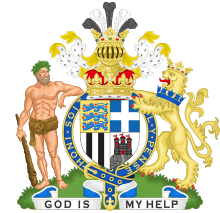Duke of Edinburgh
| Dukedom of Edinburgh | |
|---|---|
 | |
| Created by | George VI |
| Peerage | Peerage of the United Kingdom |

Duke of Edinburgh, named after the city of Edinburgh, Scotland, is a title that has been created four times for members of the British royal family since 1726. The current holder is the Prince Philip, consort to Queen Elizabeth II.
1726 creation

The title was first created in the Peerage of Great Britain on 26 July 1726 by George I, who bestowed it on his grandson Prince Frederick, who also became Prince of Wales the following year. The subsidiary titles of the dukedom were Baron of Snowdon, in the County of Caernarvon, Viscount of Launceston, in the County of Cornwall, Earl of Eltham, in the County of Kent,[1] and Marquess of the Isle of Ely.[2][3][4] These titles were also in the Peerage of Great Britain. The marquessate was apparently erroneously gazetted as Marquess of the Isle of Wight[1] although Marquess of the Isle of Ely was the intended title. In later editions of the London Gazette the Duke is referred to as the Marquess of the Isle of Ely.[5][6] Upon Frederick's death, the titles were inherited by his son Prince George. When Prince George became King George III in 1760, the titles "merged into the Crown", and ceased to exist.
Dukes of Gloucester and Edinburgh
On 19 November 1764, George III created a variation of the title for his younger brother, Prince William, the full form being "Duke of Gloucester and Edinburgh". This title was in the Peerage of Great Britain and the sole subsidiary title of the dukedom was Earl of Connaught, in the Kingdom of Ireland, a title in the Peerage of Ireland.[7] In 1805, the titles were inherited by William's only son, another William, who died without a male heir, causing the title to cease to exist.
1866 creation
Queen Victoria re-created the title on 24 May 1866 for her second son Prince Alfred, this time in the Peerage of the United Kingdom. The subsidiary titles of the dukedom were Earl of Kent and Earl of Ulster, also in the Peerage of the United Kingdom.[8] When Alfred became the sovereign of the two German duchies Saxe-Coburg and Saxe-Gotha in 1893, he retained his British titles. His only son Alfred, Hereditary Prince of Saxe-Coburg and Gotha committed suicide in 1899, so the title Duke of Edinburgh again became extinct upon the elder Alfred's death in 1900.
1947 creation
The title was created for a fourth time on 19 November 1947 by King George VI, who bestowed it on his son-in-law Lieutenant Philip Mountbatten, when he married Princess Elizabeth. Subsequently, Elizabeth was primarily known as HRH Princess Elizabeth, Duchess of Edinburgh until she became Queen in 1952. The subsidiary titles of the dukedom were Earl of Merioneth and Baron Greenwich, of Greenwich in the County of London. Like the dukedom, these titles were also in the Peerage of the United Kingdom.[9] Earlier that year, Philip had renounced his Greek and Danish royal titles (he was born a Prince of Greece and Denmark, being a male-line grandson of King George I of Greece and male-line great-grandson of King Christian IX of Denmark) along with his rights to the Greek throne. In 1957, Philip became a Prince of the United Kingdom.[10]
Dukes of Edinburgh; First creation (1726)
- Prince Frederick, 1st Duke of Edinburgh (1707–1751)
- Prince George, 2nd Duke of Edinburgh (1738–1820)
Dukes of Gloucester and Edinburgh; First creation (1764)
- Prince William Henry, Duke of Gloucester and Edinburgh (1743–1805)
- Prince William Frederick, Duke of Gloucester and Edinburgh (1766–1834)
Dukes of Edinburgh; Second creation (1866)
Dukes of Edinburgh; Third creation (1947)
- Prince Philip, 1st Duke of Edinburgh (born 1921)
- (1) Charles, Prince of Wales (b. 1948)
- (2) Prince William, Duke of Cambridge (b. 1982)
- (3) Prince George of Cambridge (b. 2013)
- (4) Prince Henry of Wales (b. 1984)
- (2) Prince William, Duke of Cambridge (b. 1982)
- (5) Prince Andrew, Duke of York (b. 1960)
- (6) Prince Edward, Earl of Wessex (b. 1964)
- (7) James, Viscount Severn (b. 2007)
- (1) Charles, Prince of Wales (b. 1948)
Future creations
It was announced in 1999, at the time of the wedding of Prince Edward, Earl of Wessex, that he would follow his father as Duke of Edinburgh. This is unlikely to happen by direct inheritance, as Prince Edward is the youngest of Prince Philip's three sons. Rather, the title is expected to be newly created for Prince Edward after it "eventually reverts to the crown"[11] after "both the death of the current Duke of Edinburgh and the Prince of Wales' succession as King."[12]
Family tree
See also
- Edinburgh
- The Duke of Edinburgh's Award
- Edinburgh of the Seven Seas
- Prince Edmund (Blackadder), for a fictitious Duke of Edinburgh
- Dukedoms of the British Isles by reign
References
- ^ a b "No. 6494". The London Gazette. 12 July 1726.
- ^ "Frederick Louis Hanover, Prince of Wales". Thepeerage.com. Retrieved 25 August 2014.
- ^ "Peerages: Eames to Emly". Leighrayment.com. Retrieved 25 August 2014.
- ^ [1][dead link]
- ^ "No. 6741". The London Gazette. 4 January 1728.
- ^ "No. 9050". The London Gazette. 16 April 1751.
- ^ "No. 10470". The London Gazette. 13 November 1764.
- ^ "No. 23119". The London Gazette. 25 May 1866.
- ^ "No. 38128". The London Gazette. 21 November 1947.
- ^ "No. 41009". The London Gazette. 22 February 1957.
- ^ "The Earl of Wessex". Royal.gov.uk. Retrieved 30 October 2010.
- ^ Whitaker's Almanack 2010, page 46 'Peers of the Blood Royal'
External links
- HRH The Duke of Edinburgh on Burke's Peerage
- Duke of Edinburgh

